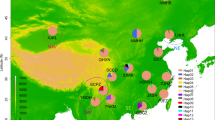Abstract
East AsianDrosophila melanogaster are known for great variation in morphological and physiological characters among populations, variation that is believed to be maintained by genetic drift. To understand the genetic properties of AsianD. melanogaster populations, we initiated a population genetic study of chromosome inversion polymorphisms in hitherto unanalysed population samples from Southeast (SE) Asia. We generally found a high frequency of each of the four common cosmopolitan inversions in comparison to populations from Africa, Asia, and Australia. In contrast to the great phenotypic variation among Asian populations, however, we could not detect differences in inversion frequencies among populations. Furthermore, we observed neither correlations of inversion frequencies with population latitude and longitude, nor evidence for linkage disequilibrium between different inversion loci. We propose two explanations for the observed genetic homogeneity among these SE AsianD. melanogaster populations: (i) the observed pattern simply reflects the retention of ancestral polymorphisms originating from a panmictic population that was once present on a large single landmass (Sundaland), and/or is a consequence of high recent gene flow between populations; and (ii) it is caused by selective forces (e.g. balancing selection).
Similar content being viewed by others
References
Ashburner M. and Lemeunier F. 1975 Relationship within themelanogaster species subgroup of the genusDrosophila (Sophophora). I. Inversion polymorphism inDrosophila melanogaster andDrosophila simulans.Proc. R. Soc. Lond. B. Biol. Sci. 193, 137–157.
Aulard S., David J. R. and Lemeunier F. 2002 Chromosomal inversion polymorphism in Afrotropical populations ofDrosophila melanogaster.Genet. Res. 79, 49–63.
Choi Y. 1977 Chromosomal polymorphism in a Korean natural population ofDrosophila melanogaster.Genetica 47, 155–160.
Choi Y., Ha Y. M. and Kim S. K. 1984 Further studies on chromosomal inversion polymorphisms in a natural population ofDrosophila melanogaster.Korean J. Genet. 6, 81–90.
Coyne J. A., Aulard S. and Berry A. 1991 Lack of underdominance in a naturally occurring pericentric inversion inDrosophila melanogaster and its implications for chromosome evolution.Genetics 129, 791–802.
Das A. and Singh B. N. 1991a Genetic differentiation and inversion clines in Indian natural populations ofDrosophila melanogaster.Genome 34, 618–625.
Das A. and Singh B. N. 1991b Chromosomal polymorphism in Indian natural populations ofDrosophila melanogaster.Korean J. Genetics 13, 97–112.
Das A., Mohanty S. and Stephan W. 2004 Inferring the population structure and demography ofDrosophila ananassae from multilocus data.Genetics 168, 1975–1985.
David J. R. and Capy P. 1988 Genetic variation ofDrosophila melanogaster natural populations.Trends in Genetics 4, 106–111.
David J. R., Bocquet C. and Pla E. 1976 New results on the genetic characteristics of the Far East race ofDrosophila melanogaster.Genet. Res. 28, 253–260.
Dobzhansky T. 1970Genetics of the evolutionary process. Columbia University Press, New York.
Inoue Y. 1979 The fate of polymorphic inversions ofDrosophila melanogaster transferred to laboratory conditions.Japan J. Genet. 54, 83–96.
Inoue Y. and Watanabe T. K. 1979 Inversion polymorphisms in Japanese natural populations ofDrosophila melanogaster.Japan J. Genet. 54, 69–82.
Inoue Y., Watanabe T. and Watanabe T. K. 1984 Evolutionary change of the chromosomal polymorphism inDrosophila melanogaster populations.Evolution 38, 753–765.
Jorde L. B., Watkins W. S. and Bamshad M. J. 2001 Population genomics: a bridge from evolutionary history to genetic medicine.Hum. Mol. Genet. 10, 2199–2207.
Knibb W. R., Oakeshott J. G. and Gibson J. B. 1981 Chromosome inversion polymorphisms inDrosophila melanogaster. I. Latitudinal clines and associations between inversions in Australasian populations.Genetics 98, 833–847.
Krimbas C. B. and Powell J. R. 1992Drosophila inversion polymorphism. CRC Press, Boca Raton.
Lefevre G. 1976 A photographic representations and interpretation of the polytene chromosomes ofDrosophila melanogaster salivary glands. InThe genetics and biology of Drosophila (ed. M. Ashburner and E. Novitski), vol. 1a, pp. 32–66. Academic Press, New York.
Lemeunier F. and Aulard S. 1992 Inversion polymorphism inDrosophila melanogaster. InDrosophila inversion polymorphism (ed. C. B. Krimbas and J. R. Powell), pp. 339–405. CRC Press, Boca Raton.
Lemeunier F., David J. R., Tsacas L. and Ashburner M. 1986 Themelanogaster species group. InThe Genetics and Biology of Drosophila (ed. M. Ashburner, H. L. Carson and J. N. Thompson), vol. 3e, pp. 147–256. Academic Press, New York.
Li W.-H. 1997Molecular evolution. Sinauer Associates, Sunderland, MA.
Mettler L. E., Voelker R. A. and Mukai T. 1977 Inversion clines in natural populations ofDrosophila melanogaster.Genetics 87, 169–176.
Nei M. 1978 Estimation of average heterozygosity and genetic distance from a small number of individuals.Genetics 89, 583–590.
Shackelton N. J. 2000 The 100,000 year ice-age cycle identified and found to lag temperature, carbon dioxide and orbital eccentricity.Science 289, 1897–1902.
Singh B. N. and Das A. 1991 Epistatic interaction between unlinked inversions in Indian natural populations ofDrosophila melanogaster.Genet. Sel. Evol. 23, 371–383.
Singh B. N. and Das A. 1992a Further evidence for latitudinal inversion clines in natural populations ofDrosophila melanogaster from India.Journal of Heredity 83, 227–230.
Singh B. N. and Das A. 1992b. Changes of inversion polymorphism in laboratory populations ofDrosophila melanogaster.Z.tzool. Syst. Evolut.-forsch. 30, 268–280.
Sperlich D. and Pfriem P. 1986 Chromosomal polymorphism in natural and experimental populations. InThe genetics and biology of Drosophila (ed. M. Ashburner, H. L. Carson and J. N. Thompson), vol. 3e, pp. 257–309. Academic Press, New York.
Van Wright R. I. 1990 The Philippines—key to the biogeography of Wallacea. InInsects and the rain forests of South East Asia (Wallacea) (ed. W. J. Knight and J. D. Holloway), pp. 19–34. Royal Entomological Society, London.
Author information
Authors and Affiliations
Rights and permissions
About this article
Cite this article
Glinka, S., Stephan, W. & Das, A. Homogeneity of common cosmopolitan inversion frequencies in Southeast AsianDrosophila melanogaster . J Genet 84, 173–178 (2005). https://doi.org/10.1007/BF02715842
Received:
Revised:
Issue Date:
DOI: https://doi.org/10.1007/BF02715842




